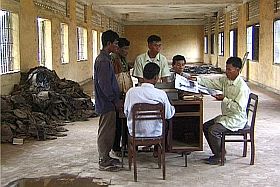


San Sebastian Celebrates the Documentary

The prestigious film festival in San Sebastian (September 17-25), one of the so-called A-festivals, has announced a special celebration of what on this site often has been called the new Golden Age of the documentary film genre, in the text below characterised as “a new heterodoxy of the genre, rich in multifarious expressions, alternative paths and unexpected solutions”. A good text from the site of the festival:
With the title of .doc – New paths of non-fiction, San Sebastian Festival will, at its 58th edition, dedicate a wide-reaching retrospective to contemporary non-fiction cinema. This cycle will include some of the most representative examples of international non-fiction cinema.
If any single phenomenon has captured attention on the world movie scene in recent years, it has to be today’s interest in documentary cinema, a practice which, save extremely rare exceptions, had followed a path largely falling by the way of the histories of cinema, international festivals and the memory of film buffs. But contemporary documentary cinema is so incredibly varied and versatile that even the classic notion of the term has to be questioned. Requirements traditionally associated to the documentary (like objectivity, a serious tone and lack of expressiveness) are no longer considered essential and can even be deliberately avoided.
Rather than documentaries, it seems more fitting talk of non-fiction cinema, a term with the virtue of encompassing this new heterodoxy of the genre, rich in multifarious expressions, alternative paths and unexpected solutions. The new cinema based on real materials shuns the reporting format and seeks other forms of recording the world around us and our relationship with it. The .doc – New paths of non-fiction cycle aims to show some of the most suggestive proposals to have appeared the world over in the last decade.
The paths followed by non-fiction cinema take us in very different and even sometimes directly opposing directions: the auto-documentary, or subjective cinema on individual, private subjects: En construcción (José Luis Guerin; 2001; Special Jury Prize at San Sebastian Festival); Más allá del espejo (Joaquim Jordá; 2006) and My Winnipeg (Guy Maddin, 2007); the self-reflective documentary, questioning itself about the documentary-maker’s position with regard to the material he or she is filming: The Five Obstructions (Lars von Trier and Jorgen Leth; 2003), essay cinema and certain forms of experimental writing: Le souvenir d’un avenir (Chris Marker and Yannick Bellon; 2001), Auge/Maschine- Parts 1, 2, 3 (Harun Farocki; 2002-2003), Los rubios (Albertina Carri; 2003), Profit Motive and the Whispering Wind (John Gianvito; 2007) and Mysterious Object at Noon (Apichatpong Weerasethakul; 2000); the fake documentary, employing the rhetoric of non-fiction to tell fictional tales: The Wild Blue Yonder (Werner Herzog; 2005); the social and historic testimonies seen from new angles, like the repercussion of individual history on collective history: S-21, la machine de mort Khmère rouge (S-21: La máquina roja de matar) (Rithy Panh; 2003); Tie Xi Qu: West of the Tracks – Parts 1,2,3 (Bing Wang; 2003) and Lucio (José María Goenaga and Aitor Arregi; 2007), the new documentary trends proposed by video-artists and moviemakers or those arising from access to digital technology; the current variations on classic documentary practices like cinéma vérité or music documentaries: The Filth and the Fury (Julien Temple; 2000) and The Devil and Daniel Johnston (Jeff Feuerzeig; 2005)…
The retrospective offers an overview of these new non-fiction trends set around a selection of the most representative titles produced the world over. Its intention is no other than to draw attention to this field as yet unexplored and unmapped, a field where commitment to reality is no impediment to formal reflection on the audiovisual medium. At the end of the day, .doc – New paths of non-fiction ultimately prompts spectators not only to question themselves on the reality around us, but also on the possibilities offered by the camera for talking about the subject.
Still: Rithy Panh: La machine de mort Khmère Rouge.
http://www.sansebastianfestival.com/in/noticia.php?ap=1&id=148